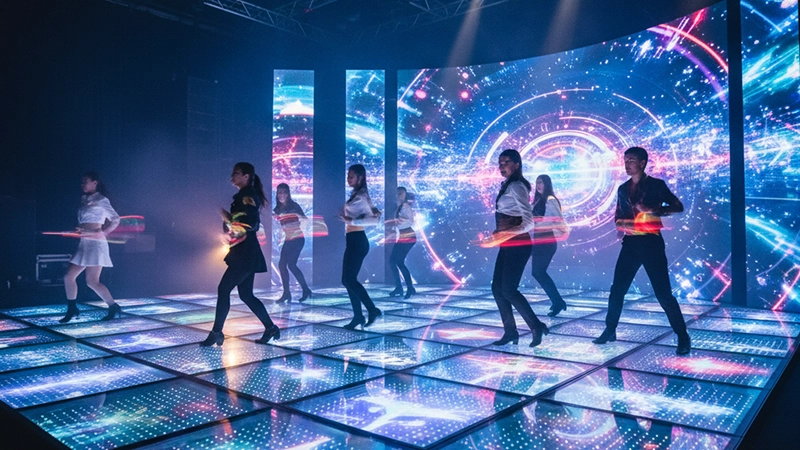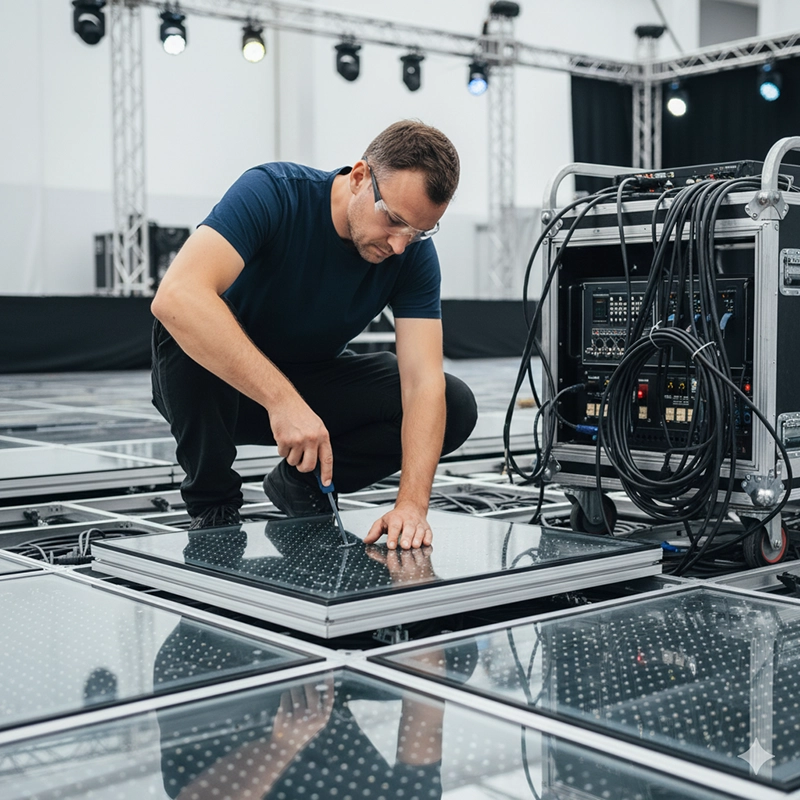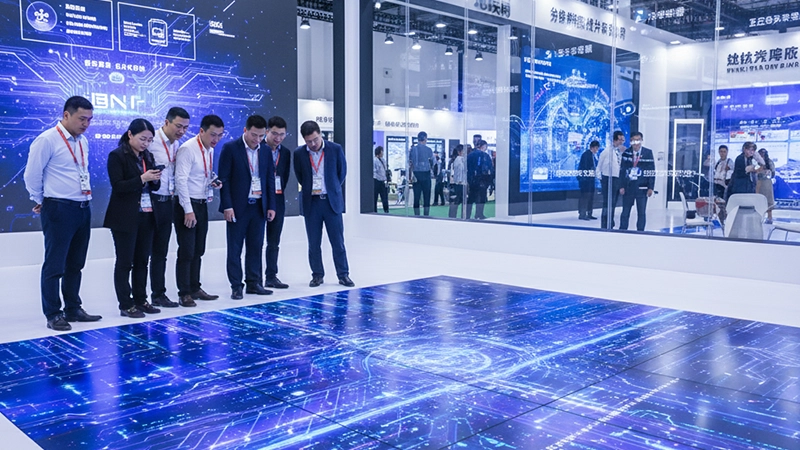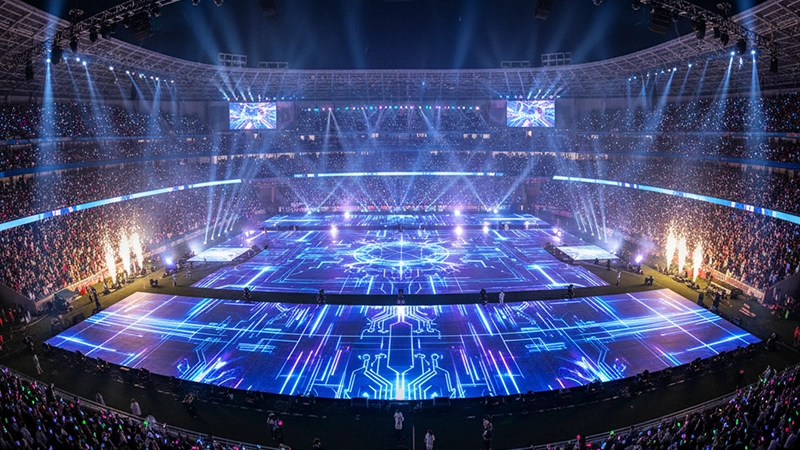An LED floor screen is a robust LED display technology engineered for horizontal installation on the ground, capable of supporting human traffic, equipment, and even heavy objects while maintaining vibrant image quality. Unlike conventional LED video walls or static flooring solutions, LED floor screens merge durability with high-definition display functions. They can be interactive, engaging audiences with responsive visuals triggered by footsteps or gestures.
These qualities make LED floor screens a preferred solution for stage productions, exhibitions, retail installations, cultural venues, and stadium entertainment. By transforming flat surfaces into immersive digital canvases, they create experiences that captivate audiences and provide businesses with innovative storytelling tools.
An LED floor screen, sometimes called a floor LED display or LED ground screen, is a specialized display solution consisting of modular LED panels designed for ground-level use. Each panel is engineered with structural reinforcement, tempered glass or PC covers, and anti-slip surface treatments.
Unlike a traditional indoor LED display mounted on a wall, a floor LED screen must endure continuous physical contact. Its design ensures both visual performance and safety.
Load capacity: Typically ranges from 1000–2000 kg per square meter.
Pixel pitch flexibility: From fine P1.5 for close viewing to P6.25 for large-scale installations.
Durability: Shock-resistant cabinets and protective coatings for high foot traffic.
Optional interactivity: Motion, pressure, or capacitive sensors for responsive effects.
Each cabinet, commonly sized at 500×500 mm, houses multiple LED modules. Cabinets are die-cast aluminum or steel for rigidity. Modules are sealed under tempered glass to protect the LEDs from impact. The modular approach enables easy assembly and replacement.
Rigorous testing ensures floor screens can withstand crowd traffic and event props. Anti-slip coatings and structural reinforcements make them suitable for stages, shopping malls, and high-footfall venues.
The working principle combines LED display engineering with structural reinforcement and, in some cases, interactive systems.
SMD LEDs: Compact, wide-angle, and high-resolution for smooth visuals.
DIP LEDs: Higher brightness and ruggedness, occasionally used in outdoor models.
Cabinets integrate heavy-duty frames and reinforced covers. Adjustable feet allow leveling on uneven surfaces.
Anti-slip treatments and transparent protective layers ensure safety without sacrificing image clarity.
Pressure sensors: Trigger content when stepped on.
Infrared sensors: Detect body movement above the floor.
Capacitive sensors: Provide precise touch-like interactions.
These features enable unique applications in retail, exhibitions, and entertainment. For example, a rental LED screen with interactivity can transform a dance floor into a responsive environment, while in live shows, floors synchronize with a stage LED screen and LED video wall for immersive storytelling.
Processors like NovaStar synchronize floor visuals with transparent LED displays in retail spaces or with outdoor LED displays in stadium entry zones. This ensures seamless integration across multiple display types.
Static LED floors provide high-definition visuals without interactivity. They are common in shopping malls, corporate lobbies, and permanent exhibition halls.
Equipped with sensors, these floors respond to footsteps or gestures and are popular in museums, theme parks, and retail activations.
Specialized content creates 3D illusions of depth and motion. Combined with stage LED screens, these floors transform concerts into immersive performances.
Designed with IP65+ protection, these floors operate reliably outdoors. They extend the applications of outdoor LED displays into walkable surfaces.
P1.5–P2.5: High-resolution for close-viewing exhibitions.
P3.91–P4.81: Balanced clarity and durability, popular for events.
P6.25: Cost-effective for large venues with longer viewing distances.
Brightness typically ranges from 900–3000 cd/m², with contrast ratios exceeding 6000:1 and viewing angles up to 160° horizontally and vertically.
Load-bearing strength is commonly between 1000–2000 kg/m². Materials and assemblies are designed to meet safety and compliance requirements for public venues.
Average power use is approximately 100–200W per panel. Operating temperature range is about -10°C to +60°C, suitable for diverse indoor and certain outdoor scenarios depending on model.
| Pixel Pitch | Resolution (per module) | Brightness (cd/m²) | Load Capacity (kg/m²) | Cabinet Size (mm) |
| P1.5 | 164×164 | 600–900 | 1000 | 500×500×60 |
| P2.5 | 100×100 | 900–1500 | 2000 | 500×500×60 |
| P3.91 | 64×64 | 900–1800 | 2000 | 500×500×60 |
| P4.81 | 52×52 | 900–1800 | 2000 | 500×500×60 |
| P6.25 | 40×40 | 900–3000 | 2000 | 500×500×60 |
| Parameter | Value Range |
| Max Power Consumption | 200W per panel |
| Avg Power Consumption | 100W per panel |
| Control Mode | Synchronous (DVI, HDMI, Network) |
| Signal Input Source | 1 Gbps Ethernet |
| Refresh Rate | 1920–7680 Hz |
| Operating Temp | -10°C to +60°C |
| Operating Humidity | 10–90% RH Non-Condensing |
| IP Rating | IP65 (front) / IP45 (rear) |
| LED Lifespan | ≥100,000 hours |
The versatility of LED floor screens allows them to be deployed across multiple industries, offering both creative freedom and practical value.
LED floors are widely used in concerts and stage shows. They work in combination with a stage LED screen backdrop and an LED video wall to produce synchronized multimedia effects. Performers interact directly with the visuals, creating a dynamic and immersive environment.
Exhibition organizers integrate LED floor screens to attract attention and guide visitors through interactive walkways. Paired with transparent LED displays, they highlight products while providing memorable experiences that increase dwell time at booths.
Retailers use LED floors to enhance storytelling. For instance, a shoe brand might create a floor display that responds with animated trails when customers walk across. Such installations integrate well with indoor LED displays mounted on walls, creating cohesive environments.
Museums adopt LED floors for interactive education, such as walkable timelines or immersive digital landscapes. In sports arenas, LED floors become part of a stadium display solution, complementing perimeter screens and outdoor LED displays at entrances for unified fan engagement.
Some churches experiment with LED floors combined with church LED displays to create atmospheric worship environments, enhancing spiritual storytelling through immersive visuals.
Audience Engagement: Interactive LED floors increase participation and emotional connection.
Creative Flexibility: Panels can be configured into squares, runways, or curves.
Return on Investment: With long lifespans and reusability, floor screens reduce long-term display costs.
System Integration: They complement other display solutions such as a rental LED screen and an LED video wall, maximizing impact.
Ease of Maintenance: Modular construction enables quick replacements without dismantling entire systems.
Pixel Pitch: Smaller pitch (e.g., P2.5) increases price but delivers sharper visuals.
Interactivity: Interactive models with sensors cost 20–40% more than non-interactive versions.
Installation Type: Fixed installations are cheaper than rental solutions with lightweight portable cabinets.
Customization: OEM/ODM options influence costs depending on unique cabinet designs or shapes.
Leading suppliers provide customization, allowing buyers to adapt designs to unique event concepts or architectural requirements. From curved floors to branded interactive experiences, customization plays a key role in B2B procurement.
Selecting the right supplier is critical for performance, safety, and ROI.
Manufacturing Standards: Ensure compliance with CE, RoHS, and EMC certifications.
Customization: Seek OEM/ODM providers who can adapt to specific project needs.
Support and Training: Reliable suppliers offer technical training and long-term support.
Project Experience: Vendors with global portfolios demonstrate proven capability.
When evaluating suppliers, procurement teams often compare not just specifications but also long-term service commitments. The right partner ensures smooth integration with existing indoor LED displays, outdoor LED displays, rental LED screens, and transparent LED displays, providing a full ecosystem.
Indoor LED Display: complements LED floor screens in retail and exhibitions.
Outdoor LED Displays: extend visual branding outdoors for stadiums or malls.
Rental LED Screen: portable for traveling exhibitions and concerts.
Stage LED Screen: works with LED floors to create immersive stages.
Transparent LED Display: ideal for storefronts, paired with LED ground visuals.
Church LED Displays: enhance immersive experiences in worship environments.
LED Video Wall: provides synchronized backdrops for events.
Stadium Display Solution: combines multiple display types, including LED floors, for sports entertainment.
LED floor screens redefine how audiences interact with spaces. From immersive concerts and retail experiences to educational museum displays and stadium ceremonies, they merge engineering resilience with creative freedom. Their integration with related solutions such as an LED video wall, a stage LED screen, and a transparent LED display further expands their potential.
For organizations seeking proven expertise, Reissopto offers advanced LED floor screen solutions backed by OEM/ODM customization, international project experience, and reliable service. By combining innovation with robust engineering, Reissopto helps businesses create impactful environments across events, retail, cultural venues, and stadium projects.
Hot Recommendations
Hot Products
Get a Free Quote Instantly!
Talk to Our Sales Team Now.
If you are interested in our products, please contact us promptly
Reach out to our sales team to explore customized solutions that perfectly meet your business needs and address any questions you may have.
Email Address:info@reissopto.comFactory Address:Building 6, Huike Flat Panel Display Industrial Park, No. 1, Gongye 2nd Road, Shiyan Shilong Community, Bao'an District, Shenzhen city , China
whatsapp:+8615217757270